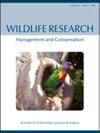这是人的问题,不是山羊的问题。在加拿大省立公园减少人类与山羊的互动
IF 1.6
3区 生物学
Q3 ECOLOGY
引用次数: 1
摘要
本文章由计算机程序翻译,如有差异,请以英文原文为准。
‘It’s a people problem, not a goat problem.’ Mitigating human–mountain goat interactions in a Canadian Provincial Park
ABSTRACT Context. Wildlife viewing is a primary reason people visit parks and protected areas. However, high rates of visitation increase the potential for interactions between humans and wildlife. This close proximity of humans and wildlife can lead to habituation to human presence and pose a threat to both animals and humans. Aims. We describe human–mountain goat interactions in Cathedral Provincial Park (CPP), in British Columbia (BC), Canada, and examine management and mitigation strategies to reduce these interactions. Methods. This project was a collaboration with BC Parks. We used community-based participatory research methodologies, conducting interviews and surveys from July 2020 to November 2021 with park visitors, staff, and researchers. Key results. Most respondents encountered mountain goats in the park and understood the park’s messaging; however, not all respondents took the necessary steps to reduce encounters. We recommend further education efforts focused on formal staff training and improved infrastructure in the park. Conclusions. Our results can be used to inform management decisions related to human–wildlife interactions, primarily in parks and protected areas. On a proximate level, we suggest further educational efforts and improved infrastructure in the park to help overcome perceived lack of action by some participants. Ultimately, there is a need to incorporate human aspects of human–wildlife interactions into management decisions aimed at addressing potential and existing problems. Implications. Using a multitude of approaches to management, informed by biological, social, and cultural knowledge, can improve responses and mitigation strategies in human–wildlife interactions. Collaboration among different stakeholders allows for the exchange of ideas and innovations that can contribute to positive movement towards coexistence of humans and wildlife in parks and recreational areas.
求助全文
通过发布文献求助,成功后即可免费获取论文全文。
去求助
来源期刊

Wildlife Research
生物-动物学
CiteScore
4.30
自引率
15.80%
发文量
56
审稿时长
3 months
期刊介绍:
Wildlife Research represents an international forum for the publication of research and debate on the ecology, management and conservation of wild animals in natural and modified habitats. The journal combines basic research in wildlife ecology with advances in science-based management practice. Subject areas include: applied ecology; conservation biology; ecosystem management; management of over-abundant, pest and invasive species; global change and wildlife management; diseases and their impacts on wildlife populations; human dimensions of management and conservation; assessing management outcomes; and the implications of wildlife research for policy development. Readers can expect a range of papers covering well-structured field studies, manipulative experiments, and analytical and modelling studies. All articles aim to improve the practice of wildlife management and contribute conceptual advances to our knowledge and understanding of wildlife ecology.
Wildlife Research is a vital resource for wildlife scientists, students and managers, applied ecologists, conservation biologists, environmental consultants and NGOs and government policy advisors.
Wildlife Research is published with the endorsement of the Commonwealth Scientific and Industrial Research Organisation (CSIRO) and the Australian Academy of Science.
 求助内容:
求助内容: 应助结果提醒方式:
应助结果提醒方式:


